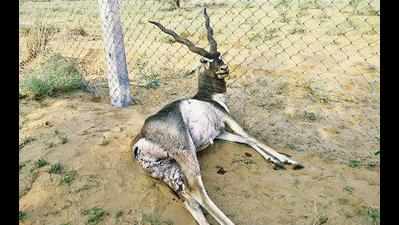- News
- City News
- rajkot News
- Blackbucks in Velavadar to get bigger safety cover soon
Trending
This story is from November 22, 2016
Blackbucks in Velavadar to get bigger safety cover soon

Representative image
Bhavnagar: The endangered blackbucks will soon get a bigger protection cover.
The forest department is likely to get a final notification declaring 727.68 sq km area around the Blackbuck National Park (BNP) in Velavadar as an eco-sensitive zone (ESZ). The department had submitted a draft proposal to the central government sometime back.
This is the only national park in the country exclusively established for conservation of blackbucks which is protected under schedule 1 of the Wildlife Protection Act.
The extent of proposed eco-sensitive zone varies from one km to 26 kms around the national park and covers 32 villages.
BNP is well-managed grassland ecosystem and therefore become an ideal habitat for migratory birds’ species including Lesser Floricans and four species of harriers.
The ESZ will help regulate the increasing salt farms in eastern and southern side of BNP as it poses threats to blackbucks and the ecosystem. There is salinity ingress in large parts of grassland area and the highly saline brine is released back into creek after removing the brine. During the sea tide, this enters the BNP area in creek. The embankment on BNP’s boundary to trap saline water for long time causes water logging and it blocks natural water ways.
“In 2002, close to 195 blackbucks and other reptiles had died outside park due to heavy water logging. Similarly, in 2007 too, nearly 190 blackbucks died due to water logging outside BNP,” an official said.
There are nearly 16 species of mammals recorded at BNP that include wolf, jackal, Indian fox, desert cat, striped hyena, jungle cat, common mongoose, desert hare and rufus-tailed hare among others. Besides, nine species of reptiles and 186 species of birds are also found in the sanctuary.
The forest department is likely to get a final notification declaring 727.68 sq km area around the Blackbuck National Park (BNP) in Velavadar as an eco-sensitive zone (ESZ). The department had submitted a draft proposal to the central government sometime back.
This is the only national park in the country exclusively established for conservation of blackbucks which is protected under schedule 1 of the Wildlife Protection Act.
The extent of proposed eco-sensitive zone varies from one km to 26 kms around the national park and covers 32 villages.
‘‘The number of blackbucks are increasing and spreading outside the national Park too. We have prepared draft ESZ keeping in view the long-term conservation of blackbucks, wolves and striped hyena too. Increasing wolf population is a good sign of protection and habitat management,’’ said A P Singh, chief conservator of forests, wildlife division, Junagadh.
BNP is well-managed grassland ecosystem and therefore become an ideal habitat for migratory birds’ species including Lesser Floricans and four species of harriers.
The ESZ will help regulate the increasing salt farms in eastern and southern side of BNP as it poses threats to blackbucks and the ecosystem. There is salinity ingress in large parts of grassland area and the highly saline brine is released back into creek after removing the brine. During the sea tide, this enters the BNP area in creek. The embankment on BNP’s boundary to trap saline water for long time causes water logging and it blocks natural water ways.
“In 2002, close to 195 blackbucks and other reptiles had died outside park due to heavy water logging. Similarly, in 2007 too, nearly 190 blackbucks died due to water logging outside BNP,” an official said.
There are nearly 16 species of mammals recorded at BNP that include wolf, jackal, Indian fox, desert cat, striped hyena, jungle cat, common mongoose, desert hare and rufus-tailed hare among others. Besides, nine species of reptiles and 186 species of birds are also found in the sanctuary.
End of Article
FOLLOW US ON SOCIAL MEDIA











